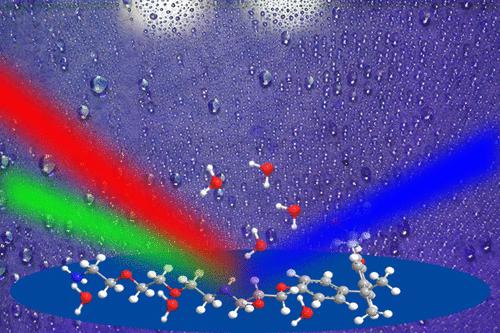Our official English website, www.x-mol.net, welcomes your feedback! (Note: you will need to create a separate account there.)
Probing Interfacial Aging of Model Adhesion Joints under a Hygrothermal Environment at a Molecular Level
Langmuir ( IF 3.9 ) Pub Date : 2024-04-15 , DOI: 10.1021/acs.langmuir.4c00696 Zhaohui Xu 1 , Gaoming Li 2 , Yinyu Zhang 2 , Yeping Wu 2 , Xiaolin Lu 1
Langmuir ( IF 3.9 ) Pub Date : 2024-04-15 , DOI: 10.1021/acs.langmuir.4c00696 Zhaohui Xu 1 , Gaoming Li 2 , Yinyu Zhang 2 , Yeping Wu 2 , Xiaolin Lu 1
Affiliation

|
Generally, for adhesive joints, the polar water molecules in humid environments can have a critical effect on the interfacial structures and structural evolution adjacent to the solid substrates. Regarding this, it is still a big challenge to detect and understand the interfacial hygrothermal aging process at the molecular level in real time and in situ. In this study, to trace the interfacial hygrothermal aging process of a classical epoxy formula containing diglycidyl ether of biphenyl A (DGEBA) and 2,2′-(ethylenedioxy) diethylamine (EDDA) with sapphire and fused silica in a typical hygrothermal environment (85 °C and 85% RH), sum frequency generation (SFG) vibrational spectroscopy was used to probe the molecular-level interfacial structural change over the time. The structural evolution dynamics at the buried epoxy/sapphire and epoxy/silica interfaces upon hygrothermal aging were revealed directly in situ. The interfacial delamination during hygrothermal aging was also elucidated from the molecular level. Upon hygrothermal aging, the interfacial CH signals, such as the ones from methyl, methylene, and phenyl groups, decreased significantly and the water OH signals increased substantially, indicating the water molecules had diffused into the interfaces and destroyed the original interactions between the epoxy formula and the substrates. Further analysis indicates that when the integrated signals in the CH range declined to their minimum and leveled off, the interfacial delamination happened. The tensile experiment proved the validity of these spectroscopic experimental results. Our study provides first-hand and molecular-level evidence on a direct correlation between the diffusion of the surrounding water molecules into the interface and the evolution/destruction of the interfacial structures during hygrothermal aging. More importantly, it is proved, SFG can be developed into a powerful tool to noninvasively reveal the local interfacial delamination in real time and in situ under extreme hygrothermal conditions, complemented by the mechanic test.
中文翻译:

在分子水平上探讨湿热环境下模型粘合接头的界面老化
一般来说,对于粘合接头来说,潮湿环境中的极性水分子会对固体基材附近的界面结构和结构演化产生关键影响。对此,在分子水平上实时、原位检测和理解界面湿热老化过程仍然是一个很大的挑战。在本研究中,追踪含有联苯 A 二缩水甘油醚 (DGEBA) 和 2,2'-(乙二氧基)二乙胺 (EDDA) 的经典环氧配方与蓝宝石和熔融石英在典型湿热环境中的界面湿热老化过程 (85 °C 和 85% RH)、和频发生(SFG)振动光谱用于探测分子水平界面结构随时间的变化。直接原位揭示了湿热老化时掩埋环氧树脂/蓝宝石和环氧树脂/二氧化硅界面的结构演化动力学。湿热老化过程中的界面分层也从分子水平得到了阐明。湿热老化后,界面CH信号,如甲基、亚甲基和苯基的CH信号显着下降,而水OH信号大幅增加,表明水分子已扩散到界面中,破坏了环氧分子式之间的原始相互作用和基材。进一步分析表明,当CH范围内的积分信号下降到最小值并趋于平稳时,发生了界面分层。拉伸实验证明了这些光谱实验结果的有效性。我们的研究提供了第一手的分子水平证据,证明湿热老化过程中周围水分子扩散到界面与界面结构的演变/破坏之间的直接相关性。更重要的是,事实证明,SFG可以发展成为一种强大的工具,可以在极端湿热条件下实时、原位无创地揭示局部界面分层,并辅以力学测试。
更新日期:2024-04-15
中文翻译:

在分子水平上探讨湿热环境下模型粘合接头的界面老化
一般来说,对于粘合接头来说,潮湿环境中的极性水分子会对固体基材附近的界面结构和结构演化产生关键影响。对此,在分子水平上实时、原位检测和理解界面湿热老化过程仍然是一个很大的挑战。在本研究中,追踪含有联苯 A 二缩水甘油醚 (DGEBA) 和 2,2'-(乙二氧基)二乙胺 (EDDA) 的经典环氧配方与蓝宝石和熔融石英在典型湿热环境中的界面湿热老化过程 (85 °C 和 85% RH)、和频发生(SFG)振动光谱用于探测分子水平界面结构随时间的变化。直接原位揭示了湿热老化时掩埋环氧树脂/蓝宝石和环氧树脂/二氧化硅界面的结构演化动力学。湿热老化过程中的界面分层也从分子水平得到了阐明。湿热老化后,界面CH信号,如甲基、亚甲基和苯基的CH信号显着下降,而水OH信号大幅增加,表明水分子已扩散到界面中,破坏了环氧分子式之间的原始相互作用和基材。进一步分析表明,当CH范围内的积分信号下降到最小值并趋于平稳时,发生了界面分层。拉伸实验证明了这些光谱实验结果的有效性。我们的研究提供了第一手的分子水平证据,证明湿热老化过程中周围水分子扩散到界面与界面结构的演变/破坏之间的直接相关性。更重要的是,事实证明,SFG可以发展成为一种强大的工具,可以在极端湿热条件下实时、原位无创地揭示局部界面分层,并辅以力学测试。



























 京公网安备 11010802027423号
京公网安备 11010802027423号